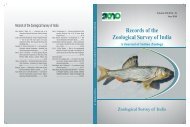Vol. 111 - Part I - Zoological Survey of India
Vol. 111 - Part I - Zoological Survey of India
Vol. 111 - Part I - Zoological Survey of India
Create successful ePaper yourself
Turn your PDF publications into a flip-book with our unique Google optimized e-Paper software.
Rec. zool. Surv. <strong>India</strong> : <strong>111</strong>(<strong>Part</strong>–1) : 37-45, 2010<br />
THE JACKALS OF TOLLYGUNGE CLUB, KOLKATA<br />
INTRODUCTION<br />
Since ancient times, our philosophy has held that<br />
the harmony <strong>of</strong> development rests on its relationship<br />
with conservation <strong>of</strong> the environment. Humankind<br />
cannot progress without a healthy and diverse natural<br />
environment. Connections between nature and society<br />
and between biological diversity and humans are<br />
critical for achieving the goals <strong>of</strong> conservation.<br />
Recently, we have an opportunity to study such<br />
circumstances in a century old club in southern part <strong>of</strong><br />
Kolkata surrounded by dense human population where<br />
a healthy and breeding population <strong>of</strong> jackals is thriving<br />
since last many years. We would like to share our<br />
experience with the readers and also caution not to<br />
term always such assemblages as man animal conflicts.<br />
The wild Golden jackals (Canis aureus) in the<br />
premises <strong>of</strong> Tollygunge Club Ltd., Kolkata have been<br />
studied during Nov.-Dec. 2008. Though it was difficult<br />
to draw any dividing line between the groups, the total<br />
population <strong>of</strong> 40-45 individuals <strong>of</strong> jackals may be<br />
grouped into approximately seven-to-eight family<br />
groups. Most <strong>of</strong> them are confined to southern part <strong>of</strong><br />
the club, except two groups roaming in the northern<br />
part. Altogether seven abandoned dens were sighted<br />
mostly located in the bushes in the eastern periphery<br />
<strong>of</strong> the club while one active den with two cubs in the<br />
centre <strong>of</strong> southern half <strong>of</strong> the club.<br />
Primarily, what we find is that the jackal population<br />
<strong>of</strong> Tollygunge Club has adapted to their surroundings<br />
and display quite different behavior from their cousins<br />
found in the wild. The most important adaptation is<br />
their diurnal habits and uncared attitude towards human<br />
beings. Their feeding, breeding social and inter specific<br />
A.K. SANYAL, J.K. DEY AND P.L. KANKANE<br />
<strong>Zoological</strong> <strong>Survey</strong> <strong>of</strong> <strong>India</strong>, M-Block, New Alipore,<br />
Kolkata-700053<br />
behavior was also studied in the club environment and<br />
was discussed in terms <strong>of</strong> availability <strong>of</strong> food as well<br />
as carrying-capacity <strong>of</strong> the club in terms <strong>of</strong> jackal<br />
population.<br />
STUDY AREA<br />
The Tollygunge club (about 100 acres) lies along<br />
eastern bank <strong>of</strong> Tolly’s Nullah which was the earlier<br />
path <strong>of</strong> a river known as Adi Ganga. Hence, the soil <strong>of</strong><br />
the club consists <strong>of</strong> the silt brought down by the<br />
erstwhile river. This nutrient rich soil and generous<br />
rainfall supported luxuriant vegetation. During<br />
colonization many exotic and indigenous plants have<br />
been systematically planted in the area which is now<br />
the abode <strong>of</strong> 118 species <strong>of</strong> plants, 93 species <strong>of</strong> birds,<br />
12 species <strong>of</strong> mammals, 7 species <strong>of</strong> reptiles and 5<br />
species <strong>of</strong> amphibians (Mookherjee, 1995) along with<br />
many fishes, mollusks and butterflies.<br />
The vegetation <strong>of</strong> the area has been thoroughly<br />
altered as per requirement <strong>of</strong> fairways and removal <strong>of</strong><br />
vegetation along the boundary wall where the animals<br />
take shelter. There are a number <strong>of</strong> small water bodies<br />
with thriving aquatic life especially mollusks and fishes.<br />
Apart from these visibly greener areas there are number<br />
<strong>of</strong> depression areas which have been converted into<br />
dumping grounds <strong>of</strong> lopped branches and leaves. These<br />
dumping points and few grooves (Map-1) are the shelter<br />
places for animal species found in the club.<br />
The club activities are mostly confined to the<br />
centrally constructed area (Map-1) which is about 15%<br />
<strong>of</strong> the total area <strong>of</strong> the club. Only golfers, horse riders<br />
and a few walkers visit the peripheral areas <strong>of</strong> the club<br />
inhabited by jackals.
















